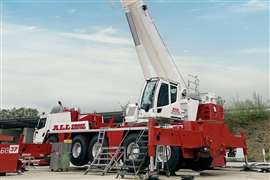Regional Report: Chinese growth hopes
25 February 2015
.gif)
Having experienced phenomenal growth over the past decade, the exceptional rise of the Chinese economy and development of its key infrastructure have begun to show signs of slowing since the end of government stimulus measures in 2010.
While this has impacted to on the construction equipment sector, as the pace of residential and commercial building slackens, even reduced GDP growth rates of around +7% have ensured a broad spectrum of major projects remained on track.
With a record number of 190,000 visitors attending the last Bauma China construction equipment exhibition, manufacturers pressed ahead in showcasing a diverse range of new machinery designed for the nation and wider region.
China’s determination to improve growth rates was shown with a decision from the central National Development and Reform Commission (NDRC) approving 21 infrastructure projects to the value of US$ 113 billion. This included five airports and 16 railway initiatives – which will build upon its growing network of high-speed train lines.
Among the most prominent ongoing schemes are projects in the East of China such as Shanghai Tower, which is presently the country’s second tallest structure.
An agreement has been signed for the US$ 13 billion new airport for Beijing, in addition to a further multi-billion infrastructure venture linking Hong Kong with the Chinese mainland.
The latter scheme attracted global headlines over what its developers have billed as one of the largest projects of its kind, which is due to reach its final phase of development next year.
Budgeted at more than US$ 10 billion, the project is, according to its designers, expected to provide both a tourism boost and help foster closer economic integration with Hong Kong.
The sheer scale of such work has aptly been summed-up by US-based Microsoft entrepreneur Bill Gates.
He took to Twitter to say he had been reading historian Vaclav Smil’s Making the Modern World, which revealed that between 2011-2013, the Chinese construction sector used a huge 6.6 billion tons of cement to fulfil its infrastructure demands and residential building programme.
This amounted to more than the US had used during the entire 20th century. Its catalysts had included development of China’s nuclear power facilities and enhancement of public transport and high-speed rail systems.
According to research from Timetric, the country’s gross construction value value for the construction industry reached US$ 2.6 trillion in 2013 (which included its annual labour costs, services, equipment and materials). This was up from a figure of US$ 200 billion recorded in 2000.
The study, based on official National Bureau of Statistics of China figures, said this had been achieved with expansion of cities and development of new urban centres over the past decade.
Despite a slowdown in growth, it has forecast the construction market will reach output levels of US$ 3.9 trillion by 2018, with around 8% real term annual growth predicted.
As Danny Richards, analyst at Timetric’s Construction Intelligence Centre, explained, the upturn experienced in the residential sector had been driven by government targets.
These were outlined in its national New-type Urbanisation Plan (2014-2020) outlining a drive towards 60% of the population living in cities within the next five years, compared to its present level of 54% of people.
Significantly, in January 2014, the government relaxed its one child policy and this has since seen nearly 1 million couples apply for permission to enlarge their families. This is likely to provide further medium-term stimulus to residential development.
Mr Richards said, “The market buoyancy reflects a number of factors: continued rapid urbanisation and industrialisation, population growth, rising household incomes and government investment in expanding and upgrading physical infrastructure.
“There are numerous mega-projects in development in the areas of transport infrastructure, city subways, airports, utilities and waste management, as well as power generation.
“This plan shows the need for further investment in urban infrastructure such as new expressways and railways to link all cities with more than 200,000 people by 2020, and high-speed rail services to connect cities with more than a half million.”
The analyst added that the country also needed to invest in public-funded affordable housing projects. This includes ambitions to provide 23% of the urban population with affordable housing by 2020 requiring more than 4 million new housing units a year to be built over the next five years.
Despite such policies, housing supply issues have emerged and led to some emerging urban developments such as Chenggong in South West China being labelled as “ghost cities”. According to the World Bank, the major new community had been a hit by a significant portion of a scheme of 100,000 apartments remaining unsold since its creation.
Similarly, in Kangbashi - the new city of Ordos, northern China, remains sparsely populated, which the government is attempting to address by inviting rural populations to take up residence.
According to Chinese state media, there are an estimated 45 million people across the country employed in the construction sector. It remains at the heart of the economy, with residential schemes still ranking high in its overall contribution.
National statistics revealed that total investment in real estate reached US$ 1.3 trillion (with residential building investment of US$ 910 billion and commercial and office building at
US$ 257 billion).
However, health and safety standards remain one of the main issues facing the industry. This was highlighted by Terex China president Ken Lousberg at the International Rental Conference held in Shanghai last November. He said the company had a “moral obligation” to help raise levels of construction best practice.
Consequently, the Chinese government has announced that it will not issue construction permits to projects without worker insurance.
Pressure on construction companies
While conditions have been challenging within the Chinese construction market, manufacturers remain hopeful that an improving picture may soon emerge in the sector.
Dave Beatenbough, vice president for research and development at Liugong, expressed his opinion that the recent construction challenges in China had begun to “reach the bottom of the trough” and a sense of gradual recovery was starting to take hold.
He said, “The market in China during 2014 has been down by 15%, which we have felt as everyone else has done. But we have had some good runs in terms of excavators for the region.
“There has been some adjustment to that rapid pace that had left a lot of excess production of around 100,000 machines in the market, though that’s something we had seen coming and taken account of with our own production levels.
“Excavators have been our biggest area of focus for us this year and we have been working really hard on the mid sector of around 20 tonnes, as well as ranges between 36-50 tonnes, including the 950E.”
A similar picture emerged for other companies including JCB. Its sales managing director Guy Robinson said it had been “an extremely tough” year for its operations in China.
However, he explained there had been an encouraging picture with its excavators, which recorded an upturn in market share.
He said, “We expect the Chinese market for excavators to be flat in 2015, but we will be adding new models to our range. Having a plant in the country has helped to raise our profile but, more significantly, the localisation of manufacturing has cemented our position as a credible construction equipment manufacturer in China.”
Companies such as XCMG have continued to focus on enhancing the quality and range of products for the domestic market.
This included setting up a drivetrain research and development operation which saw investment of RMB 200 million (US$ 32 million), as well as exhibiting a total of 45 machines at Bauma China.
Its line up featured equipment as diverse as its 400-tonne excavator through to what it reported as being the world’s first wheeled-crawler crane among its range for 2015.
Projects
One of the largest schemes under development in China is the US$ 13 billion being invested to develop a second airport for Beijing.
Initial work on the facility at Daxing, which is around 45 km south of the capital, began last month. The project is being fast-tracked as a priority and is expected to be completed within three years.
The four-runway airport has been designed by Dutch consultancy NACO and will feature a 700,000 m2 terminal and will benefit from rail links to Beijing and its neighbouring cities.
According to the company, the site has been developed with particular attention to sustainable design principles through creating strong links with public metro systems via its on-site ground transport centre.
Further along the east coast, construction developments within Shanghai have continued with large-scale projects being delivered.
Among the city’s most notable ventures has been the creation of the US$ 2.4 billion 121-storey Shanghai Tower in the Lujiazui commercial district. Built to a height of 632 m, its distinctive twisting design stands as China’s second tallest building and is due to open this year.
The project was started in 2008, and has contended with a number of technical challenges including a 60-hour continuous concrete pumping operation as part of its dense foundations, which feature 831 reinforced concrete bored piles. Its slender design has been adapted to minimise wind resistance.
Bolstering its reputation as China’s most westernised city, this year will also see the opening of Shanghai’s multi-million dollar new Disney Resort Park modelled on US-themed attractions.
On an equally grand scale, the much-hyped Sky City tower in Changsha has attracted plenty of media headlines, but has yet to be delivered despite initial groundworks being tested in 2013.
Broad Sustainable Building, which is behind the scheme, remains hopeful its plan for the vertiginous 838 m building, which would be the tallest in the country, will still go ahead.
However, concerns remain over its potential construction methods, which have claimed it is possible to erect within a few months using unconventional off-site pre-construction. The company said it is “still working to gain permits” surrounding building safety certificates to enable its development.
This year will also prove a critical one for the major US$ 10 billion Hong Kong– Zhuhai – Macau Bridge, which links the former colony to the Chinese mainland.
The project, which spans a total of 29 km, is said to be the largest of its kind in the world, with RMD Kwikform acting as a consultant and supplier for the scheme.
Having begun in 2009, the scheme is due for completion next year and it is hoped the venture will foster increased tourism opportunities.
Encouraging greater visitor numbers has been identified by the government as a key economic driver for the country, which has offered key potential benefits to the construction sector.
This has been seen with new plans unveiled to promote tourism to the north western region of China. Consequently, Shaanxi province has created a US$ 804 million fund to improve its infrastructure.
Linked to this, Gansu province, which has 1,600 km of the Silk Road route, is also investing heavily in connecting urban areas with sites of national significance and tourism value.
It is initiatives such as this which have underpinned the United Nation’s assessment that China is set to become the world’s largest tourist destination by 2020.
While the country is experiencing a period of adjustment as its rate of growth adapts towards more sustainable levels, the range and scale of planned investment in its infrastructure has offered an optimistic outlook for its construction sector.






